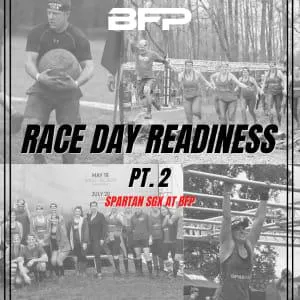WEIGHT LOSS & FITNESS BLOG

Race Day Readiness Pt. 2
Race Day Nutrition
One would hope that your nutrition is fairly healthy in general, given the amount of time and effort that goes into training for a Spartan Race. In general, you should focus on lots of whole foods, lots of lean proteins, very few processed foods and sugars, and very little alcohol consumption.
Carb Loading
What is carb loading? Is it necessary? In general, if you are running a Sprint (3.1 miles + 20 obstacles) or a Super (6.2 miles + 25 obstacles), you shouldn’t need to carb load unless you are planning to run both races in a single weekend. Carb loading becomes necessary when you plan to run the Beast (13.1 miles + 30 obstacles), Ultra (30 miles + 70+ obstacles), or Hurricane Heats (4 hours, 12 hours, or 24 hours).
Carb loading is a gradual increase in the percentage of carbohydrate caloric intake over the span of the few days before a race. It does not mean that you eat a higher volume of food for several days in a row. It also does not mean that you eat one massive carbohydrate heavy meal the night before (one large meal may not be digested in time and may remain in the GI tract the next day when you begin your race). It means that you continue to eat the same volume of food at the same frequency as you always do, you just slowly add in more carbohydrates, while decreasing the amount of proteins and fats, over the two to three days before the race.
Race Nutrition
In terms of the day before, it is best to have an early lunch, a moderate dinner, and an evening snack. Keep the volume of food at each meal moderate so that your body has plenty of time to digest and assimilate your food.
The morning of your race, it is best to eat a substantial meal anywhere from three to five hours before competition in order to maximize glycogen storage (glycogen is the fuel your body will use to power you through the race). Your meal should be made up of easily digestible carbohydrates, and it should be low in protein, fat, and fiber. Make sure you eat familiar foods - never try something new on race day, so this is something that you will want to experiment with in advance. You’ll also want to have a small snack one to two hours before event (great examples are energy bars, gels, or gummies).
Typically you do not need to bring food with you during shorter Spartan distances (Sprints and Supers). Studies show that carbohydrate ingestion during exercise lasting longer than 45 minutes can improve endurance capacity and performance because it helps maintain blood glucose levels. Carbohydrates are the primary fuel source during a Spartan race. The form of that food doesn’t matter, whether it is bars, gels, gummies, sports drinks, or real food. Make sure that you try those foods on several occasions before Race Day. In terms of when to eat during an endurance event, it is best to start consuming carbohydrates 30-45 minutes into the event, before you get hungry. Typically you’ll want to have 1g glucose/minute of activity and 6 oz of carbohydrate solution every 15-20 minutes (these are your sports drinks - Gatorade, Powerade, Body Armor, etc.).
You’ve likely used most of your glycogen stores, so your first post-race meal should focus on carbohydrates. There is some debate about how soon after competition one should refuel. Some researchers recommend refueling with carbs as soon as possible - within 30 minutes of exercise. Some researchers say that you need to refuel within a few hours. I will say that if you are planning to run two or more races back to back, i.e. a trifecta weekend, then you should do your best to refuel as quickly as possible so that your body has as much time as possible to digest and assimilate the nutrients before your next race.
Hydration
In general, you should aim for a daily hydration goal of drinking in ounces the equivalent of one half your body weight in pounds. So a 150 lb. female should aim for 75 oz. of water a day (between 8 and 10 cups) and a 200 lb. male should aim for 100 oz. of water a day (between 12 and 14 cups).
Race Hydration
When it comes to hydrating in the days before a race, I recommend drinking a full 16 oz. over your normal daily water intake for three to four days before the race. It is a good idea to make that additional 16 oz. something that has electrolytes and/or salt in it - Gatorade, Powerade, BodyArmor, LiquidIV, etc. Electrolytes, which is just a fancy way of discussing sodium, chloride, potassium, are especially important for prolonged endurance (3+ hour events) - 1g electrolytes/1L water. If you know that your event will take place outdoors on a “hot” day (meaning temperatures will reach at least 70 degrees or higher), you’ll want to drink even more.
On the morning of the race, you’ll want to consume between 8-16 ounces of liquid as part of a pre-competition meal. Again, I recommend something with electrolytes, salt, or even a glass of orange juice.
There are a lot of variables to determine exactly how much to drink during exercise. The actual amount you should drink depends upon length of exercise, pre-exercise drink volume, urine volume, sweat loss (drink more on a hot day), but you’ll want to aim for somewhere around 1-1.25 oz/minute of exercise. For shorter races, the water stations are typically enough to get you through the competition. For longer races, you may want to bring an extra bottle of water/sports drink that fits in a large pocket or fanny pack or wear a hydration pack.
Your post-race goal is to fully replace any fluid deficit. So you should drink 1.5 pints of fluid for every pound of body weight lost. You’ll want to drink fluids with added sodium to help with fluid retention. Salt capsules, sport drinks, gels, salty food, pickle juice. Similar to post-race nutrition, if you plan to run two or more races within a day or two, the sooner you can replenish your fluids, electrolytes, and sodium, the better recovered you will be for the next race.
Hydration Packs
Are hydration packs necessary? Similar to the standards for carb loading, hydration packs are typically used for longer distance races - the Beast (13.1 miles + 30 obstacles), Ultra (30 miles + 70+ obstacles), or Hurricane Heats (4 hours, 12 hours, or 24 hours). Ideally your hydration pack has at least a 1liter reservoir and storage for food. You might even consider possible storage for a windbreaker if the weather is rainy.
There are different types of hydration packs and you’ll want to go to a sporting goods store to try them on to determine which is most comfortable. Straps should have some padding and fit snug and the pack should be tight to your back. You won’t want the pack banging against you as you run and it should be small enough that you won’t get caught on barbed wire or low hanging branches. Once you select a pack that is comfortable, make sure you wear it during training; get comfortable wearing it while climbing, running, and crawling.


Are you Ready to become
sTRONG - FIT - cONFIDENT?
Click the Button To Start Your Journey Today!!

